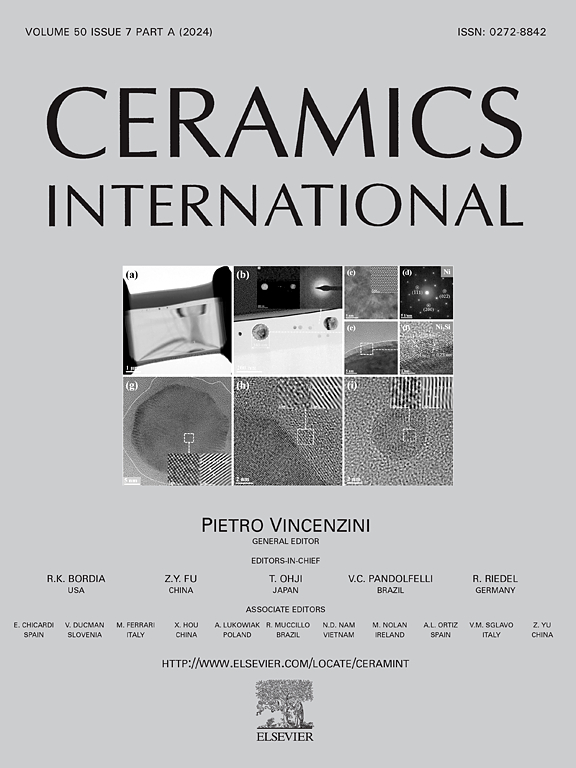Enhancement of osteogenic potential and surface wettability of polycaprolactone using hydroxyapatite co-doped with vanadium and yttrium
IF 5.6
2区 材料科学
Q1 MATERIALS SCIENCE, CERAMICS
引用次数: 0
Abstract
Although advanced composites are becoming more common in therapeutic applications, there is still a significant need for materials that combine improved mechanical properties with biological functionality for successful bone tissue engineering. This study aimed to develop a novel polymeric nanocomposite by incorporating vanadium and yttrium co-doped hydroxyapatite (HVY) into a polycaprolactone (PCL) matrix using the solvent casting method. For the first time, rare-earth metal yttrium was co-doped with vanadium to enhance the mechanical and biological performance of polymer composites for bone tissue engineering. The incorporation of HVY significantly improved mechanical strength from 26.30 ± 0.37 MPa to 48.58 ± 0.42 MPa, while enhancing surface hydrophilicity, as evidenced by a reduction in the contact angle from 102.98° to 62.16°. Porosity and degradation studies over 21 days demonstrated a satisfactory and controlled degradation rate suitable for bone regeneration applications. Biomineralization capacity was confirmed through the deposition of calcium and phosphate on the composite surface after immersion in simulated body fluid (SBF). Antibacterial tests revealed potent activity against S. aureus and P. aeruginosa, with inhibition zones of 9.05 ± 0.8 mm and 7.15 ± 0.6 mm, respectively. Hemocompatibility testing indicated a hemolysis rate of less than 5 %, while over 80 % viability of rat bone marrow-derived stromal cells (rBMSC) confirmed the non-toxic nature of the composites. Osteogenic differentiation assays, including ALP and ARS, showed outstanding performance, suggesting the significant potential of the prepared material for promoting bone development and regeneration. This study bridges a critical gap in the development of biomaterials by introducing a rare-earth metal co-doping strategy, providing a promising biomaterial for bone tissue engineering applications. The findings underscore its potential as a highly effective, easily fabricated biomaterial that meets all the essential criteria for successful bone tissue engineering.
钒钇共掺杂羟基磷灰石增强聚己内酯的成骨潜能和表面润湿性
尽管先进的复合材料在治疗应用中变得越来越普遍,但为了成功的骨组织工程,仍然需要将改进的机械性能与生物功能结合起来的材料。本研究旨在通过溶剂铸造法将钒钇共掺杂羟基磷灰石(HVY)加入聚己内酯(PCL)基体中,制备一种新型聚合物纳米复合材料。首次将稀土金属钇与钒共掺杂,提高了骨组织工程用聚合物复合材料的力学性能和生物性能。HVY的加入显著提高了材料的机械强度,从26.30±0.37 MPa提高到48.58±0.42 MPa,同时表面亲水性增强,接触角从102.98°降低到62.16°。超过21天的孔隙度和降解研究表明,令人满意的和可控的降解率适合骨再生应用。在模拟体液(SBF)中浸泡后,通过钙和磷酸盐在复合材料表面的沉积来证实生物矿化能力。对金黄色葡萄球菌和铜绿假单胞菌具有较强的抑菌活性,抑菌范围分别为9.05±0.8 mm和7.15±0.6 mm。血液相容性测试表明溶血率低于5%,而大鼠骨髓基质细胞(rBMSC)的存活率超过80%,证实了复合材料的无毒性质。包括ALP和ARS在内的成骨分化实验显示了出色的表现,表明制备的材料具有促进骨发育和再生的巨大潜力。本研究通过引入稀土金属共掺杂策略,填补了生物材料发展的关键空白,为骨组织工程应用提供了一种有前途的生物材料。这些发现强调了它作为一种高效、易于制造的生物材料的潜力,它满足了成功的骨组织工程的所有基本标准。
本文章由计算机程序翻译,如有差异,请以英文原文为准。
求助全文
约1分钟内获得全文
求助全文
来源期刊

Ceramics International
工程技术-材料科学:硅酸盐
CiteScore
9.40
自引率
15.40%
发文量
4558
审稿时长
25 days
期刊介绍:
Ceramics International covers the science of advanced ceramic materials. The journal encourages contributions that demonstrate how an understanding of the basic chemical and physical phenomena may direct materials design and stimulate ideas for new or improved processing techniques, in order to obtain materials with desired structural features and properties.
Ceramics International covers oxide and non-oxide ceramics, functional glasses, glass ceramics, amorphous inorganic non-metallic materials (and their combinations with metal and organic materials), in the form of particulates, dense or porous bodies, thin/thick films and laminated, graded and composite structures. Process related topics such as ceramic-ceramic joints or joining ceramics with dissimilar materials, as well as surface finishing and conditioning are also covered. Besides traditional processing techniques, manufacturing routes of interest include innovative procedures benefiting from externally applied stresses, electromagnetic fields and energetic beams, as well as top-down and self-assembly nanotechnology approaches. In addition, the journal welcomes submissions on bio-inspired and bio-enabled materials designs, experimentally validated multi scale modelling and simulation for materials design, and the use of the most advanced chemical and physical characterization techniques of structure, properties and behaviour.
Technologically relevant low-dimensional systems are a particular focus of Ceramics International. These include 0, 1 and 2-D nanomaterials (also covering CNTs, graphene and related materials, and diamond-like carbons), their nanocomposites, as well as nano-hybrids and hierarchical multifunctional nanostructures that might integrate molecular, biological and electronic components.
 求助内容:
求助内容: 应助结果提醒方式:
应助结果提醒方式:


